Yes! it takes two to tango but does it take two to tandem? Can one person paddle a tandem kayak? It is very exciting to paddle with your partner but what happens when you need alone time on the water.
This will cause you to wonder; Can I, as a person paddle a two-person kayak? Can I easily maneuver this vessel or strike a balance? Will it be difficult or will it be fun paddling alone?
Here comes the good news! This article will provide answers to your question as well as give you helpful suggestions as regards how to set up a tandem kayak for your personal use and the best tandem kayaks suitable for you to paddle as a person.
You will get tips on how to choose a two-person kayak for yourself as well as the pros and cons of you singly paddling a tandem kayak among other frequently asked questions about the tandem kayak.
Reading this article to the end will guide your choice on going for what is suitable and best for you.
Table of Contents
Can One Person Paddle a Tandem Kayak?
The answer is a big Yes! Of course, one person can paddle a tandem kayak. Worrying about it being fun? This will depend on the model of the kayak and your choice of comfort in either sitting in the front or back seat.
If you take a position to paddle at the back, the boat will be unbalanced and the bow will ride high and will be easily caught by the wind.
Although sitting in the front seat will give you minimal control of the kayak as the kayak’s nose is more likely to dip underwater in case you encounter any waves.
You can find it more difficult to use, leaving room for potential problems during trips unless you use certain models of a tandem kayak.

There are a few models of tandem kayaks that allow paddlers to adjust the seat locations to where a solo kayaker will sit in the center where they can better control the kayak.
The best style of a two-person kayak suitable for one person is one that allows you sit-on-top and allows you to remove or adjust the seats.
Many tandem kayaks allow you the option of a third seat apart from the traditional two seats, which makes it easier for you to clip a seat in the central position.
This way, you will have better control of the kayak regardless of its length anyway!
What is a Tandem Kayak?
As the word “tandem” itself implies partnership or conjunction, a tandem kayak is a type of kayak built for two people paddling together.
The basic difference between a tandem kayak which is a two-person kayak and a kayak for one person is the number of seats.
While a tandem kayak has two seats, a kayak for one person has one. The tandem kayak can accommodate two persons while on a single kayak, there’s room for only one person.
Although a tandem kayak is slightly heavier than a kayak built for one person, paddling both boats requires the same paddling techniques.
However, you need to keep your movements in sync to keep full control over the tandem kayak.
You can purchase a 2-person kayak for an adventurous time with your partner and still decide to paddle it alone, especially on days when you decide to go solo.

Surprisingly, a tandem kayak can be used solo. Although you may face problems posed by differences in weight distribution which may cause you to struggle with steering, tracking, and responsiveness.
Fortunately, in the latter part of this article, you would be learning how to overcome these performance problems and get helpful suggestions on how to set up that two-person kayak for solo use.
Pros of One Person Paddling a Tandem Kayak
Have you ever been unmotivated to go solo on a tandem kayak due to some suggestions that there are not many advantages to one person paddling a tandem kayak?
Guess what? We have a list for you on the pros of one person paddling a tandem kayak:
- More storage space
- More leg room
- Feeling of stability
- Pet kayaking
More Storage Space
If you target the center of the tandem and set up your kayak seat in that central position, trust me, you will have a lot more storage room towards the bow and stern.
This is why you see some multi-day kayakers deliberately choosing a larger two-person kayak for their overnight adventures.
You need to take caution with this advantage regardless by applying a little creativity in your styles for strapping gear to your kayak.
This is because you will be storing it in unusual locations which are originally meant for human riders.
More Legroom
When you are Taller as a paddler, troubles may be inevitable with all types of kayaks.
It is either you are struggling to fit in the cockpit of a sit-inside single kayak or your feet are crouching up on the sides of your partner’s seat.
If you’re taller than 6’5, you’re faced with a real struggle but fortunately, taller paddlers can be a beneficiary of the tandem kayak and you can enjoy paddling by converting it for solo use.
The best style of tandem kayak that is fit for this purpose is the sit-on-top style which provides the most leg room possible for you.

Feel More Stable
Manufacturers have a maximum weight capacity set for every kayak they manufacture. It is therefore advisable that you avoid passing the boundary mark of 70 to 80 percent of the advertised weight capacity of a particular kayak.
Exceeding the weight capacity over time makes maneuvering harder and the boat will be much slower and less responsive to your paddle strokes.
However, you have added stability paddling a two-person kayak since you won’t be exceeding the allotted percent of the weight capacity and having a significant surface area of a tandem’s hull resting in contact with water, which gives your kayak a feel of more stability.
Pet kayaking
Another advantage of the tandem kayak is that it allows you to take your pet along. So, you can go happily kayaking, giving your pet space at the front while you enjoy quality time.
You do not have to worry about the complexities involved in kayaking with your pet as you can easily stick him in the front seat of the two-person kayak.
Also, your child can learn to paddle and steer a kayak with the help of a tandem kayak. If you’re wondering what boat is fit for you to teach your child, then a tandem kayak is fit.
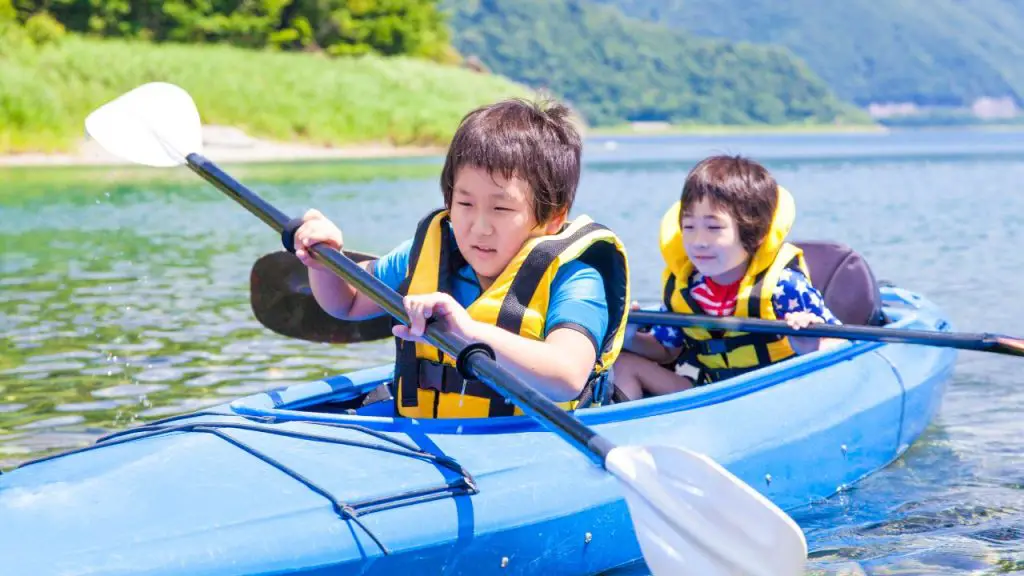
Cons of One Person Paddling a Tandem Kayak
Going solo on a tandem kayak comes with its difficulties as well. These problems present themselves as:
- Less maneuverability
- Harder to maintain speed
- Heavier to transport and balance
- Difficulties in setting up the kayak
Less Maneuverability
The first obvious disadvantage to paddling a kayak especially when it is a bit oversized is that it will pose harder for you to maneuver.
This implies that you will find it more difficult to make quick turns. Depending on the conditions, minor adjustments could pose an issue too.
If the water body you are paddling on is a calm or slow-moving river, maneuvering may be less of an issue.
But if your interest lies in fast-moving water or fishing in narrow creeks and streams, you may find it difficult to maneuver.
Difficulty in Maintaining Speed
If you are going solo on a two-person kayak, you will find it difficult to keep up with the speed of the other individuals paddling as partners in the same water body as you are.
Moreover, these tandem kayaks are built to be powered by two paddlers sitting strategically in the cockpit.
When learning how to go solo on a kayak, you will become conscious of how the angle of your paddle’s shaft in relativity to the water’s surface affects the amount of force that you can exert with each stroke.
But when you paddle at an angle perpendicular to the surface of the water, you will generate more power as you are on a higher paddle angle.
The reason for this explanation is that paddling a tandem kayak by yourself majorly requires you to sit at the broadest part of the boat as opposed to the narrower places you would be sitting.
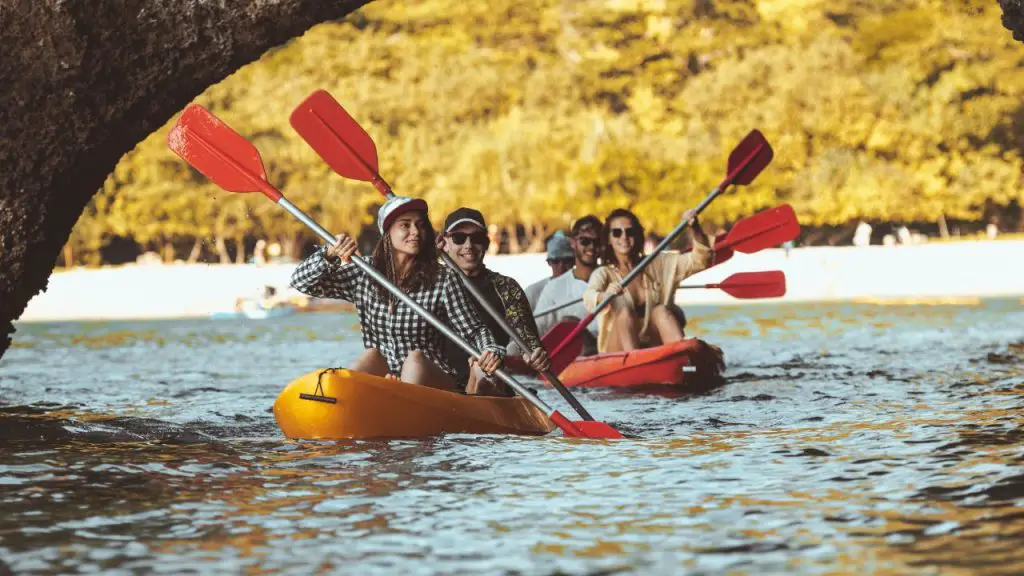
This will make it a bit difficult for you to achieve a higher paddle angle because you may likely find yourself trying to adapt your paddle stroke by reaching out over the gunwales.
Heavier to Transport and Balance
Transporting a tandem kayak to and from the water’s edge might be an issue because of its weight which is heavier than a regular kayak.
On days when you can not rely on your paddle partner to aid you in carrying your kayak down the shore, transporting it from your vehicle is going to be difficult unless you find something that has a wheel that can make it easier to move.
Getting the kayak balanced on the water is going to pose difficulty for you as you may struggle with striking the balance between your weight and the heavy weight of the boat.
Difficulty in Setting Up The Kayak
The type of kayak as well as your method of setting it up will determine how difficult paddling solo can be.
You may not get the full benefits of going solo on a tandem kayak if you do not understand the setup of the particular model kayak you want to paddle.
How to Set up a Tandem Kayak for One Person
The setting up of a tandem kayak is as important as paddling it as the way you set up your tandem kayak will determine your experience at the end of the day.
Adjust The Seat Towards The Middle
If your tandem kayak has moveable seats, then half of your problems regarding going solo on a two-person kayak are solved.
Since the seats in your kayak allow for movement, simply adjust the rear seat up to the center of the cockpit. While one seat can be relocated, the other can as well be removed.
This will allow for the weight to be better distributed and fix the issue of your tandem kayak looking like a skinny motorboat from a lop-sided trim.
If your tandem kayak has a non-removable seat, you do not have to panic. You can still go solo.
For a rigid kayak modeled as a sit-on-top, as long as the third seat is at the center, all you need to do is set up the seat in the middle of your kayak’s cockpit by using the central anchor points on the gunwales.
If it is a sit-inside kayak you want to go solo on, it is best to sit in the rear seat. In this way, you will gain the most control of the kayak’s direction.
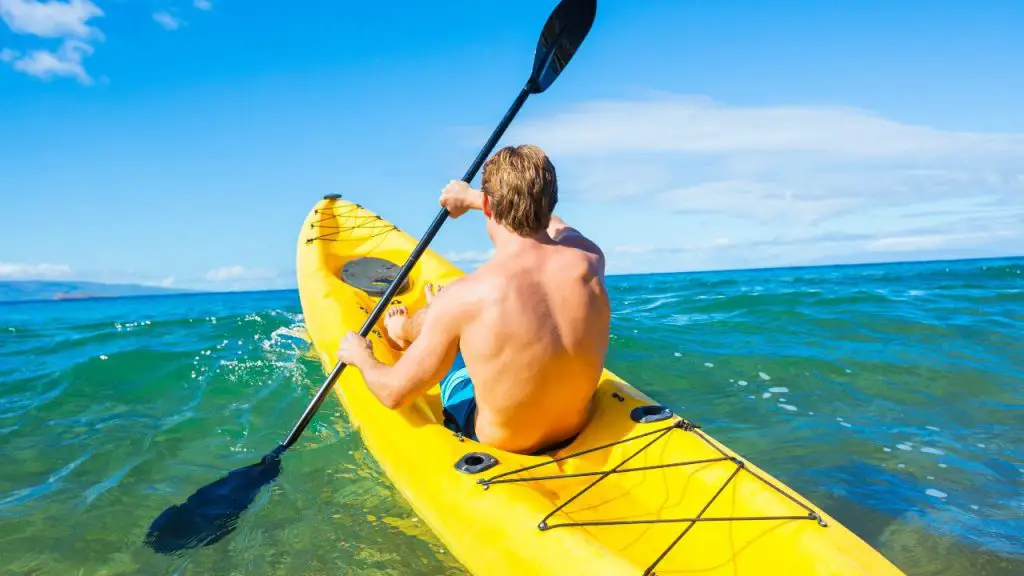
Weight Distribution
If you want to paddle a two-person kayak as a single person, you need to rectify every weight distribution problem to strike the needed balance for your trim.
How do you go about this weight distribution you may ask? It’s simply by adding some weight of course!
To do this, the front of your kayak needs to be fitted with weights.
The weights could be more than 50 lbs and a lot of things can be used, for example, bottled water.
The weight should be placed near the tip of the bow; as close as possible and if you are working with a hard shell, you should adjust the weights at the far ends of the kayak.
If you are using a kayak that does not allow you access to the bow edge, you can tightly fix the weight in the hatch closest to the bow.
If your kayak is a hatch-less inflatable sit-on-top boat, you may need to get creative about how to stow/attach weight to the front of your boat and keep it from sliding around.
Suffice it to say that adding weight to the front of your kayak will rectify your trim and keep your boat in better balance.
- Tandem kayak with dogs
- You can use bottles of water
- Position the weight as near the tip of the bow as you can
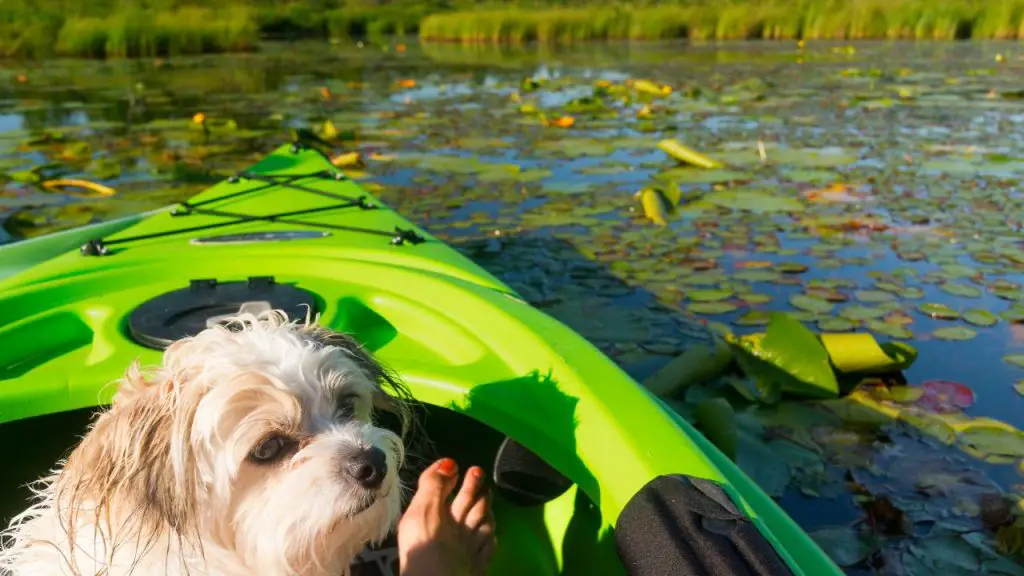
Use a Longer Paddle
A longer paddle becomes of immense benefit to you during this setup because there is a relocation of your kayak seat to a wider location.
You will be able to keep your power strokes more vertical without losing your balance contrary to the previous location of your seat where your paddle stroke is shallower and less efficient
Install a Rudder (or Skeg) to Improve Performance
It becomes easier for you as a single paddler to direct a tandem kayak in heavier winds when you install a rudder.
The installation of this blade at the stern of your kayak serves the basic purpose of helping you keep your kayak on course in harsh weather conditions and strong currents as well as aid you in turning your boat.
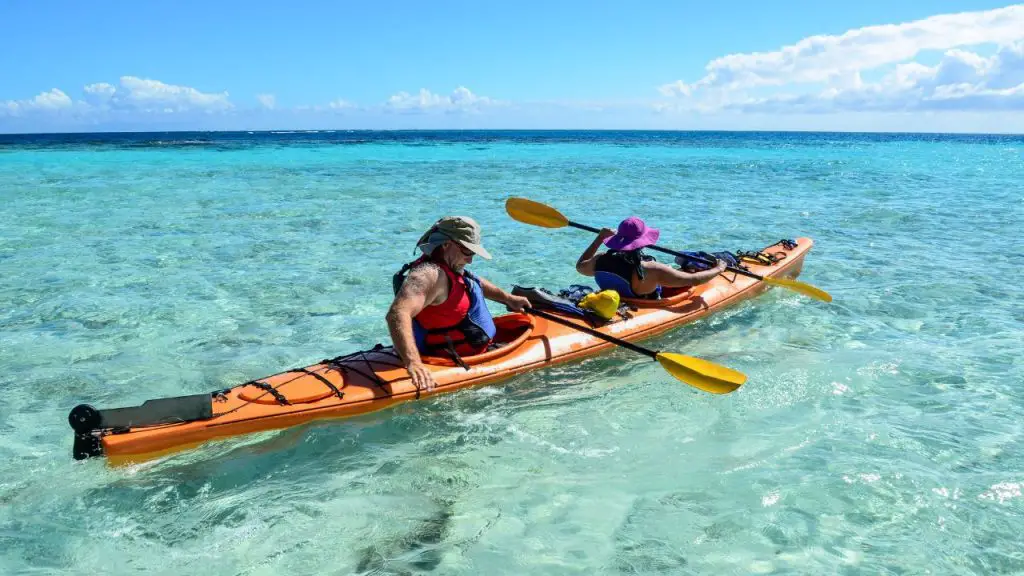
When navigation poses a difficulty, an alternative blade to use is the skeg which is housed in your kayak’s bottom. You can employ the use of a skeg to prevent the slipping out of your kayak’s back end when crosswinds blow.
While a rudder helps your boat achieve turns around corners, a skeg will help you in tracking straight. Moreover, both are useful in controlling and improving your performance in maneuvers when you go solo on a tandem kayak.
3 Best Tandem Kayaks For One Person
There are three best tandem kayaks suitable for you as a person who wants to paddle singly. They are:
- Ocean Kayak Malibu
- Intex Excursion Pro Kayak Series
- ADVANCED ELEMENTS AdvancedFrame Convertible Elite Inflatable Kayak
Ocean Kayak Malibu
The Ocean Kayak Malibu has a wide design of about 34 inches across. Paddlers of different heights can get in comfortably because of plenty of molded-in footrests.
Measuring 12 feet in length, this kayak allows a maximum of 425 pounds as its weight capacity.
With the optional third seat at the center, this kayak is suitable for paddling as a single person and serves recreational purposes while paddling on calm waters.
The cost of an ocean kayak Malibu ranges from $500 to $1000 which is dependent on the size of the vessel you desire to purchase
Intex Excursion Pro Kayak Series
Of the tandem inflatable kayaks being built, this is the most affordable and one of the best. It comes with footrests built into the cockpit floor which allows for a more effective paddling angle.
It is suitable for a solo paddler as the inflatable seats can easily be adjusted. It comes with fishing rod holders as well as an adjustable mounting bracket where you can attach your preferred holder wherever you go kayak fishing.
This Intex excursion pro Kayak series is very affordable compared to an ocean kayak as you can get one at the cost of $280. With some versions of these series selling at $150, there are also expensive versions of the Intex excursion pro kayak series.
ADVANCED ELEMENTS AdvancedFrame Convertible Elite Inflatable Kayak
This kayak has a 15-foot length which implies a lot of storage room for your camping gear. It is a good one for touring as a single person as you can efficiently paddle long distances.
This high-performing inflatable has a more rigid frame compared to other inflatable kayaks because of its unique aluminum rib frame.
It allows for cold weather paddling because of its coaming that allows the attachment of the best kayak spray skirts. Its three layers of heavy-duty PVC tarpaulin material allow for tear resistance and added puncture.
This inflatable kayak costs between $850 to about $1300 and unlike other inflatables, their multiple layers of material afford them durability.
Tips to Choose A Two-Person Kayak?
Here are helpful tips for choosing a tandem kayak:
If you plan on going kayaking alone or you are interested in spending alone time on the water, go for a solo kayak rather than a tandem kayak.
If you are someone who enjoys companionship and likes to go kayaking with a companion, it is better to go for a tandem kayak.
If you want to buy a kayak that can serve both purpose and aid flexibility you choose a convertible tandem kayak.
FAQs
Can one person go in a two-person kayak?
Yes, more than one person can, and tandem kayaks are used to achieve this.
Is it hard for one person to paddle a tandem kayak?
No, it is not as long as all the tricks are known.
Is it easier to kayak single or double?
Kayaking with a partner is easier as long as your strokes synchronize.
Is single or tandem kayaking easier?
Single kayaking is easier because most tandem kayakers struggle with synchronization.
Why are tandem kayaks called divorce boats?
They are called divorce boats because people with ending marriages buy them.
Key Takeaways
With some of the difficulties associated with going solo paddling on a tandem kayak, it is better to go for a one-person kayak rather than a tandem kayak when thinking of purchase.
However, you can weigh your options in light of the advantages, disadvantages, water experience as well as difficulty in setting up and making your choice.



